[ad_1]
Ophiopogon spp.
A beautiful, low-growing and mounding ground cover, mondo grass is an ideal ornamental for low traffic areas.
Not a true grass at all, these tuberous-rooted perennials from the Ophiopogon genus belong to the asparagus family, Asparagaceae. They grow in attractively dense clumps with gracefully arching, narrow leaves of dark green to black, and are easily cultivated.

We link to vendors to help you find relevant products. If you buy from one of our links, we may earn a commission.
Several varieties are commonly used in the home garden for their handsome, evergreen foliage, easy care, and shade tolerance. These plants grow well in full sun, but they really shine in light shade.
Colonizing slowly, they’re an attractive, non-invasive alternative to traditional sod and turf.
Non-fussy and adaptable, they work in many settings such as beds, borders, containers, geometric plantings, and underplantings, or in gravel, meditation, and Mediterranean gardens. And they work nicely as ground cover as well.
Plus, thanks to their ability to spread, they’re an excellent choice as a sod-forming stabilizer for banks, creek sides, slopes, and general erosion control.
Summer brings small, bell-shaped flowers of lilac or white that bloom on short racemes, producing pea-sized, black to blue berries, cheekily peeking out from the foliage.
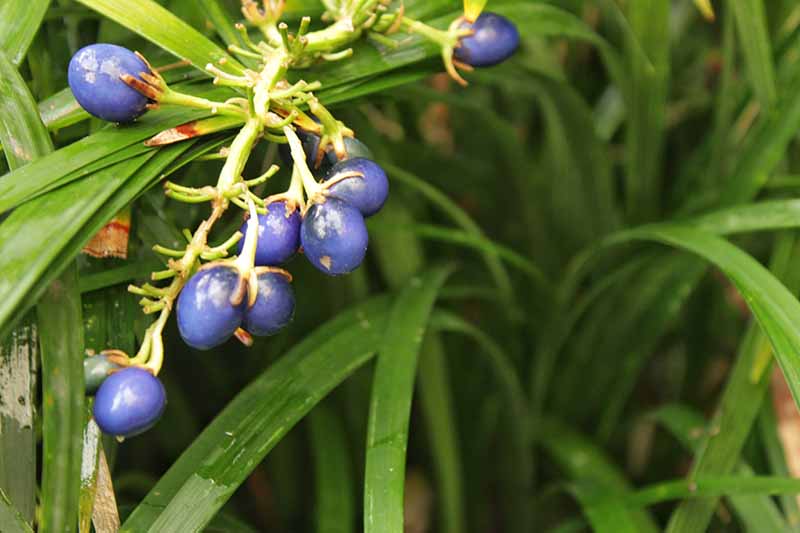
An evergreen with a tidy, easy habit, mondo grass spreads by underground stolons or runners and propagation by root division is fast and easy.
Pretty, low-maintenance, and made for the shade – does this sound like an ornamental your garden needs? Then let’s dive in for a closer look at how to grow mondo grass!
Here’s everything we’ll cover up ahead:
What Is Mondo Grass?
Also known as monkey grass, Ophiopogon species are native to parts of southeast Asia, including China, Korea, Japan, and Vietnam.
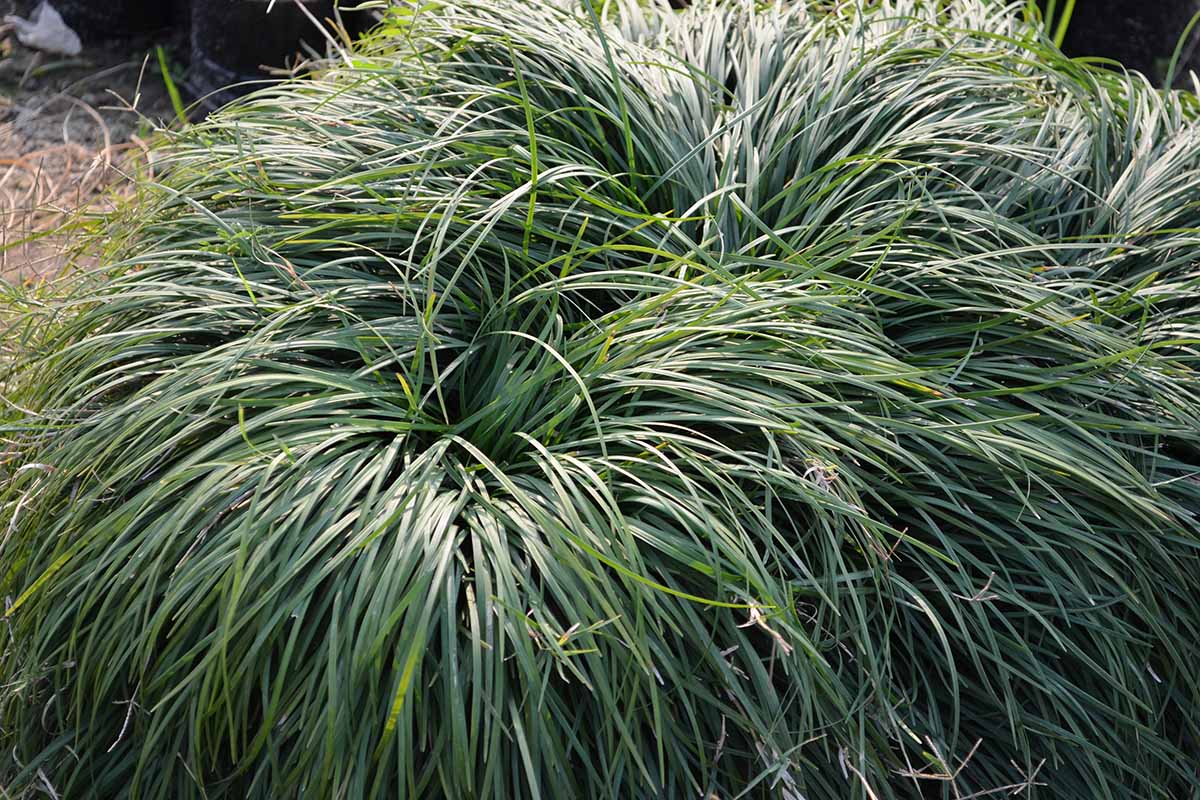
Easy to care for and not fussy about location, they’re well-suited for growing in the home garden or landscape, with the dark green O. japonica being the most commonly cultivated species.
But other species and various cultivars are popular as well, including selections with black foliage like O. planiscapus ‘Nigrescens,’ the variegated cultivar O. jaburan ‘Vittatus,’ and charming dwarf varieties such as O. japonica ‘Nana.’
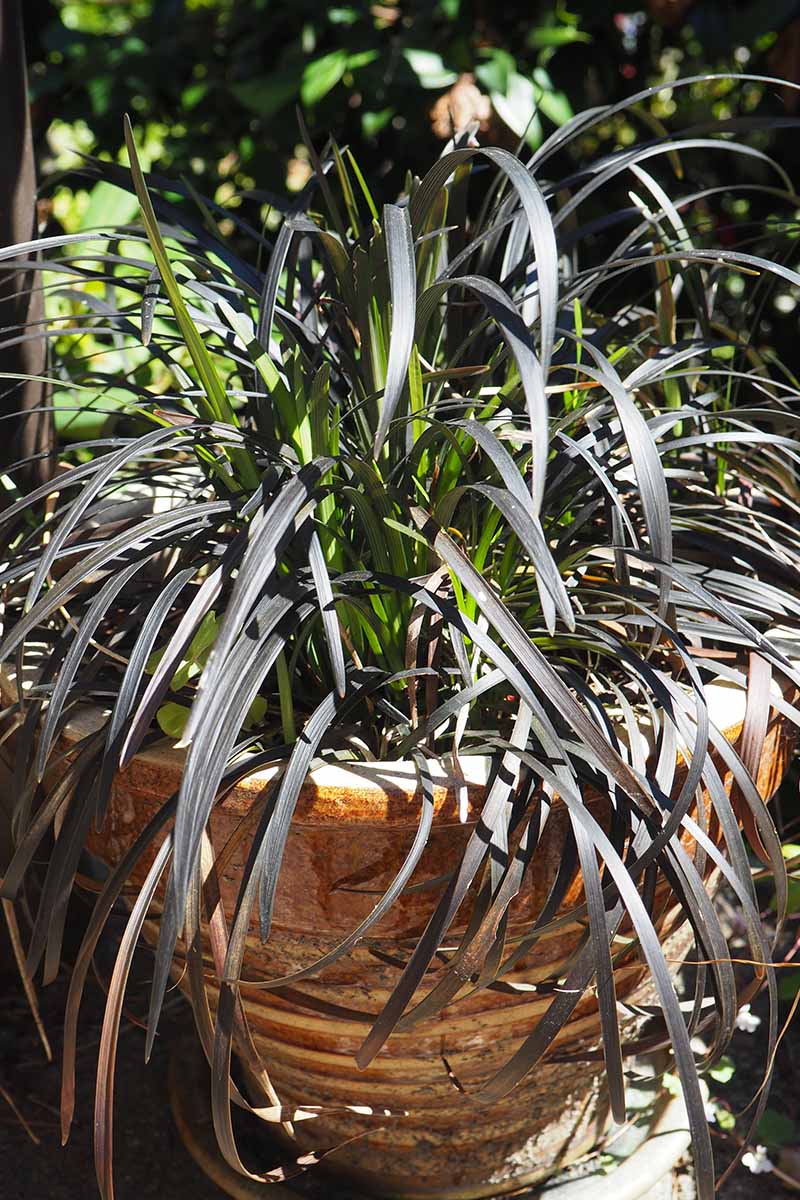
Ophiopogon is often confused with another Asparagaceae family member called lilyturf, Liriope, which is considered invasive in parts of North America.
Like many narrow-leaved ornamentals, species in the genus Ophiopogon are misnamed as grasses, but belong to an entirely different family as noted above, Asparagaceae.
They feature thin, fine to medium-textured leaf blades of dark green to black that grow six to 12 inches tall in a graceful, arching habit. Plants spread 12 to 18 inches wide and form dense, slowly spreading clumps.
Small racemes of mauve to white, bell-like flowers appear in early summer, followed by pretty, pea-like berries of bright blue to black in autumn. Both flowers and berries are partially hidden by the foliage, giving an elusive appeal when spotted.
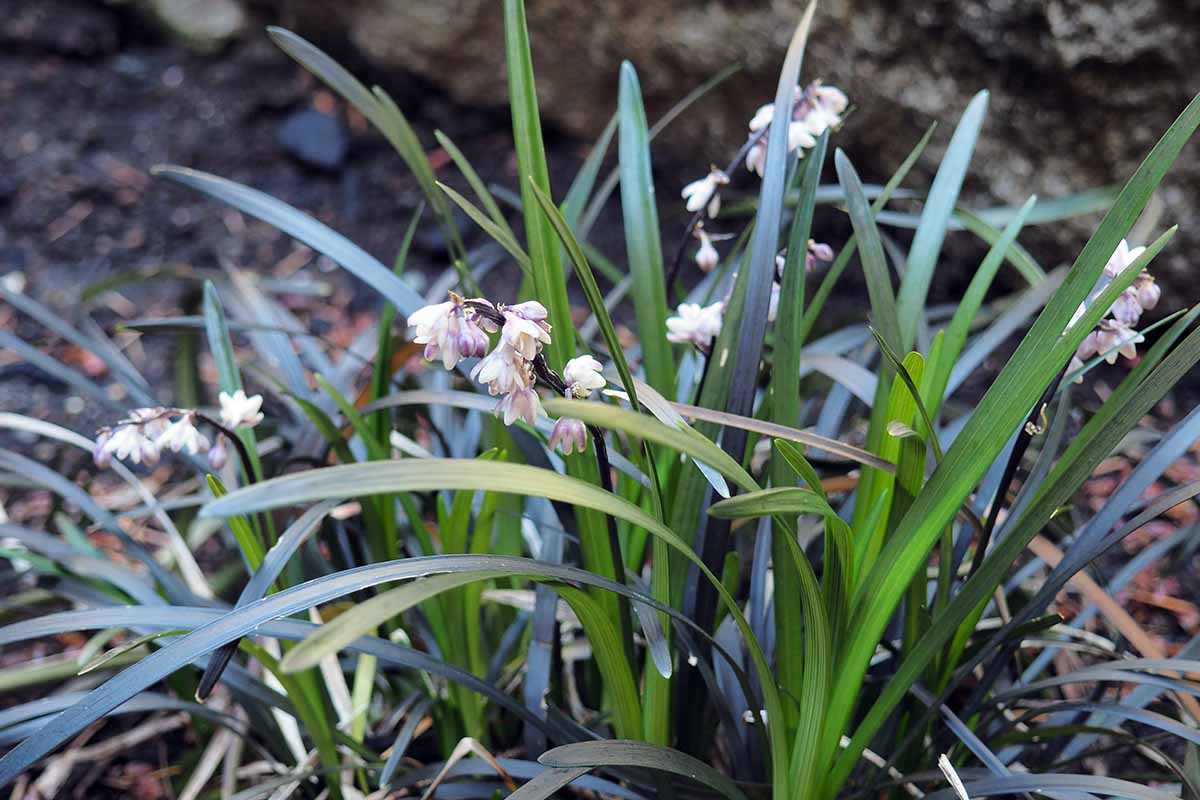
With tuberous roots, plants spread via underground runners, creating a thick and tough ground cover – but their pokey pace makes these evergreens non-invasive and easily controlled.
Plants are deer and rabbit resistant with good salt tolerance, a boon for coastal gardeners. Hardy in Zones 7 to 11, some cultivars are suitable for growing in Zones 5 and 6.
Certain types of Ophiopogon are sometimes sold as aquarium or bog plants but these are short-lived in aquatic environments because they’re not true water plants.
Their favorite environment provides filtered sun to full shade, and lightly moist and well-draining soil.
Cultivation and History
Native to fertile, humus-rich forests and plains of southeast Asia, mondo grass varieties have long been used in classic Japanese gravel or zen gardens.
And in traditional Chinese medicine, the roots and tubers are used to treat and balance deficiencies in yin forces.
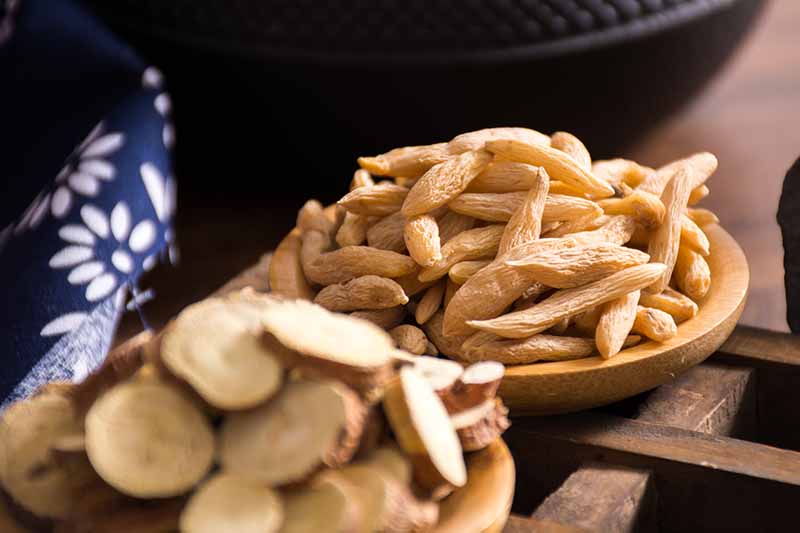
The genus name Ophiopogon is derived from the Greek words ophios, which means dragon or snake, and pogon, which means beard – the dragon’s beard is thought to reference the flower spikes.
Propagation
Propagation is most easily done in spring by dividing side shoots or large clumps.
To divide large clumps, insert a clean, sharp spade straight into the soil all around the plant, tracing the outermost foliage tips.
Use the spade to lift the tuberous root clump.
Gently brush off excess soil, then divide the roots with your fingers or use a clean, sharp knife, to separate into equal divisions.
Ensure each division has eight to 12 leaves and plenty of healthy tubers and feeder roots.
Plant as outlined in the How to Grow section below.
To divide side shoots, carefully loosen the soil around the root ball then gently pull the roots away from the parent.
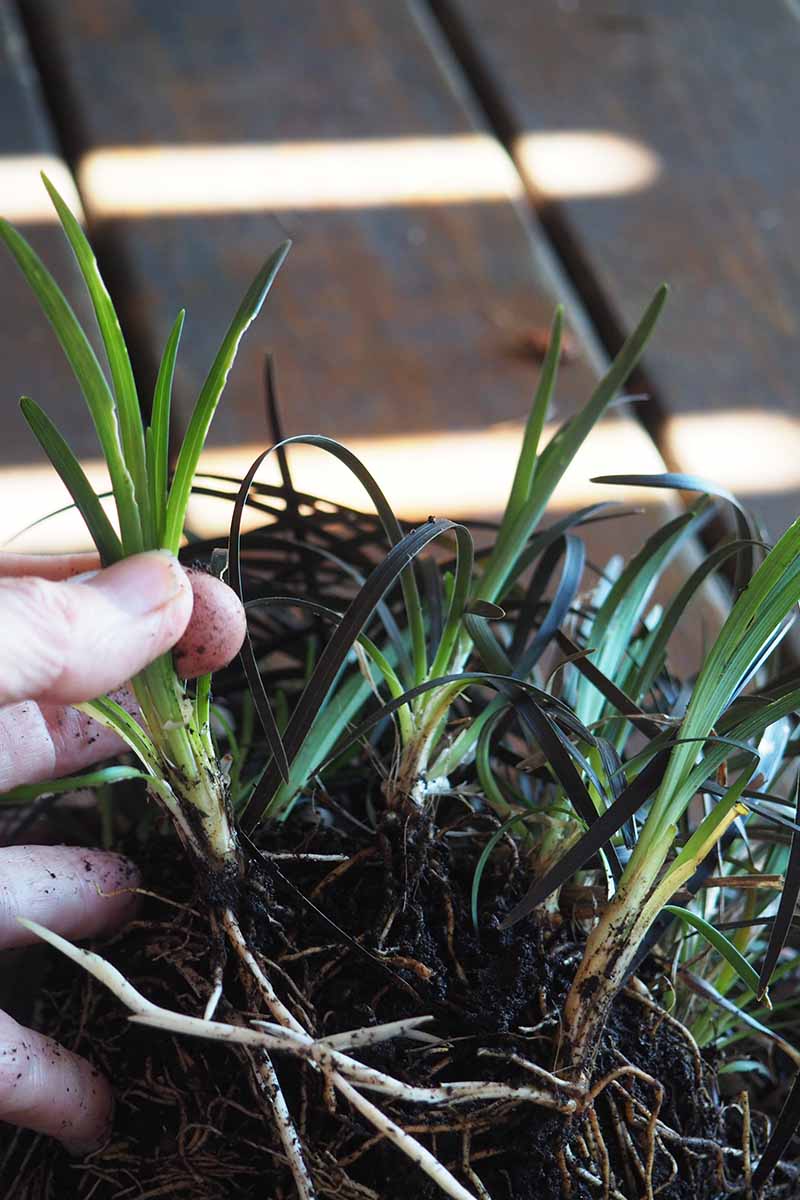
Ensure each shoot comes away with healthy roots.
Pot up into four- to eight-inch containers. Place in a sheltered spot in the garden that receives morning sun with afternoon shade, or lightly dappled shade.
Water regularly to keep the soil moist, then transplant into the garden when plants put on new growth.
Move small containers into a frost-free area over the winter as needed.
How to Grow
Mondos grow best in well-draining garden soil enriched with organic matter such as compost or aged manure, with a slightly acidic pH of 5.5 to 6.5.
These will grow in full sun to full shade, but they really thrive in areas of filtered sun or dappled shade. Shade-grown plants typically have a darker foliage color than those planted in full sun.
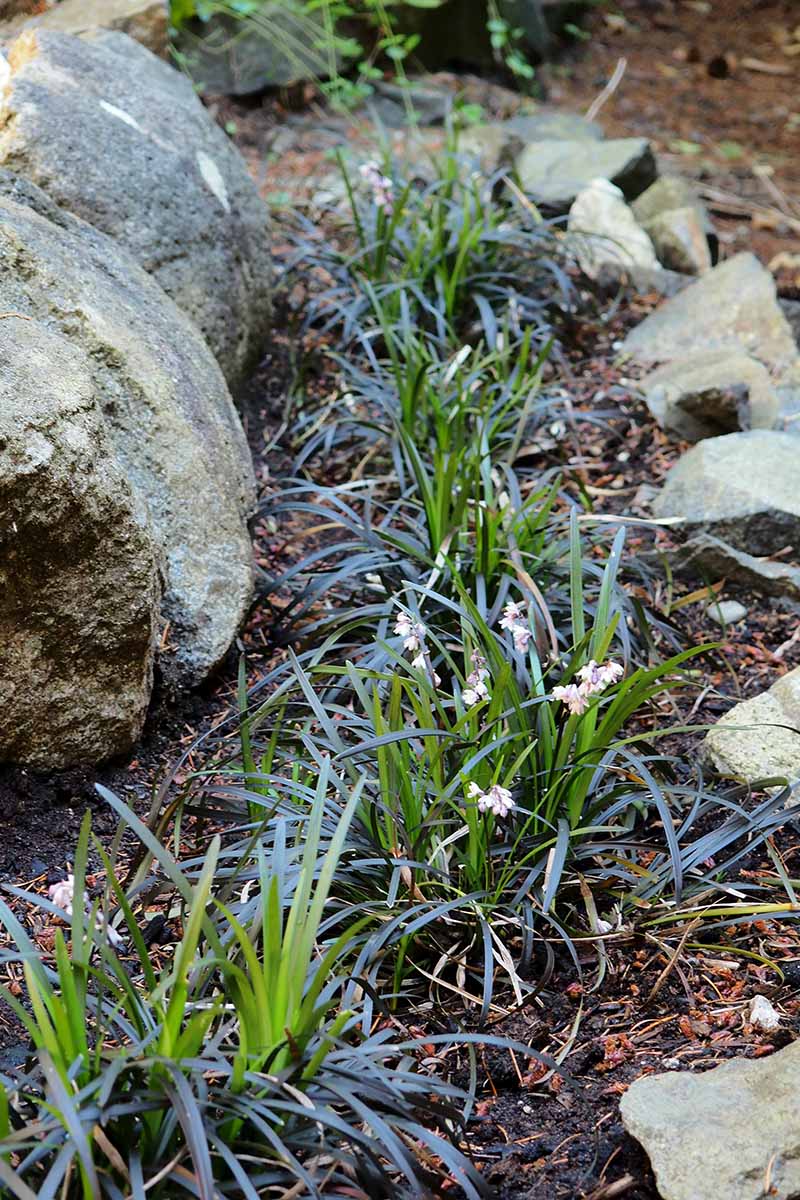
Create planting holes the same depth and twice the width of root balls, spacing them four to 12 inches apart, or two to four inches apart for dwarf varieties.
Amend the soil with organic matter as needed and mix in some bone meal for healthy root growth.
Set plants with the crown positioned just below soil level then backfill.
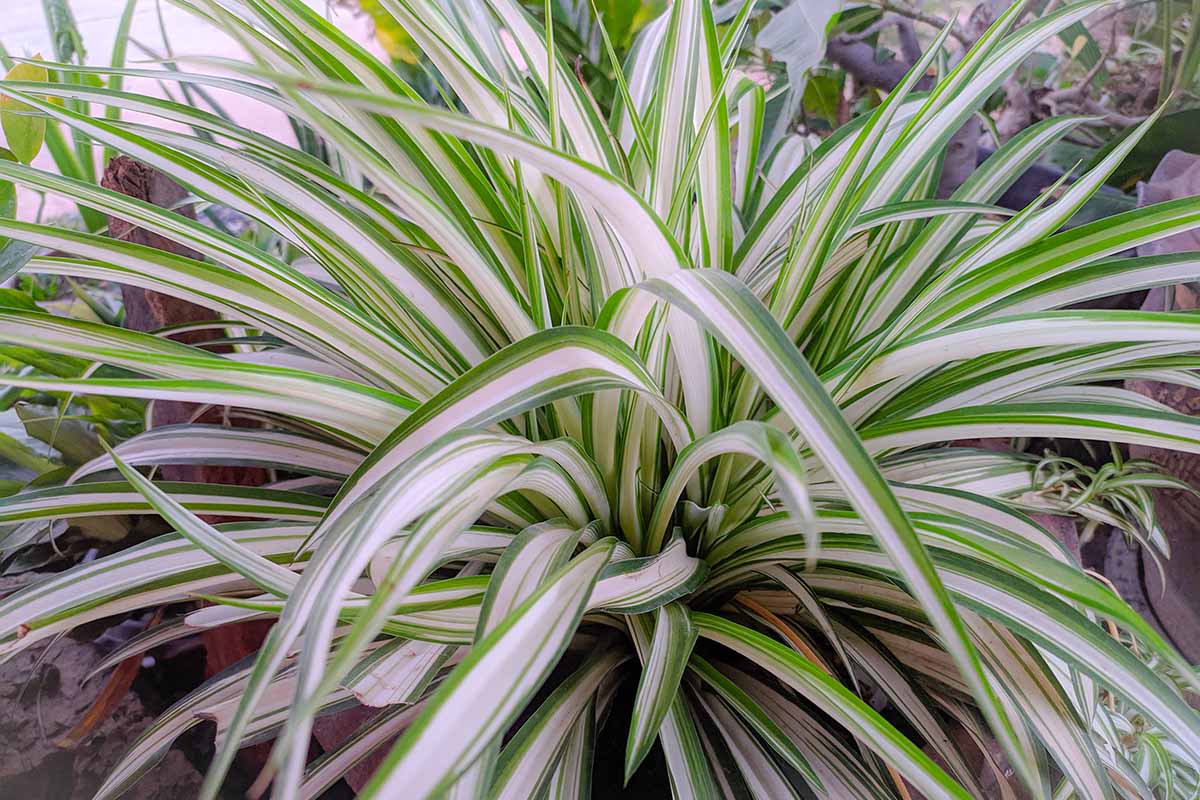
Gently firm the soil and water lightly to settle, then water weekly in the absence of rain to provide slightly moist soil.
To keep weeds down and retain soil moisture, add a two-inch layer of leaf mold or straw mulch around plants.
For container growth, I like to first line pots and planters with a layer of drainage material, such as broken pottery or pebbles.
Fill the pots with a humus-rich soil mix amended with moisture-retentive materials such as coconut coir, peat moss, perlite, or vermiculite.
Mix in some bone meal for healthy, strong roots then plant with the crowns just below the soil line and firm in place.
Water gently to settle in place and provide water weekly or when the top inch of soil is dry, keeping the soil lightly moist until established.
Plants prefer lightly moist soil but are drought resistant once established – note that their growth slows even more in dry conditions.
In spring, give container plants a side-dressing of organic matter such as compost or apply a balanced, slow-release fertilizer.
Growing Tips
Mondos require little from the gardener, but the following tips are useful for cultivating healthy, happy plants:
- Top or side dress with compost or well-rotted manure in spring to provide nutrients for the entire growing season.
- Established plants are somewhat drought tolerant but should be watered during extended dry periods of a month or more.
- Ophiopogon plants spread, but they do so slowly – for an immediate impact, space plants closer.
These are low-maintenance specimens. A couple of annual chores will keep them looking their best.
Pruning and Maintenance
Attractive year round, plants may turn brown in cooler regions or can become a bit ragged by winter’s end.
If needed, use clean, sharp garden shears to cut back mounds of old, shaggy or dead leaves in early spring before new growth emerges. Cut back by a third to half of their full length.
Mondo grasses are not heavy feeders but benefit from a one- to two-inch layer of top-dressing such as compost laid over beds in early spring.
Alternatively, apply a slow-release granulated fertilizer in early spring using a balanced 10-10-10 NPK formula, or a shrub and tree formula such as 18-6-12 NPK.
Large specimens can be divided every three years. Container plants should be allowed to become slightly root bound before dividing and repotting.
Species and Cultivars to Select
New cultivars are being introduced regularly, but here are a few suggestions to get you started.
Black Beard
Large, dark, and highly ornamental, ‘Black Beard’ (aka O. planiscapus ‘Yapard’) features long, strappy leaves of the deepest purple-black in beautiful, arching mounds.
Small spikes of pale lavender flowers adorn plants in summer followed by inky-black berries in autumn.
Tough and non-fussy, these easy-care plants reach a mature height of 12 to 15 inches with a spread of 18 to 24 inches. Hardy in Zones 7 to 10.
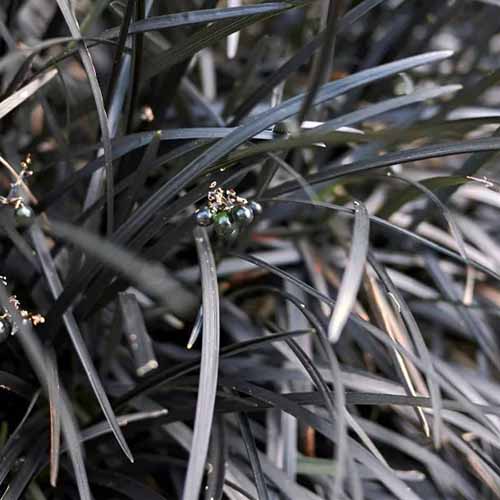
‘Black Beard’
A unique choice for banks, beds, borders, edging, and planters, plus ground covers and underplanting, they’ll also do well in city, coastal, courtyard, and gravel gardens.
Container plants are available at Nature Hills Nursery.
Nana
Half as big as the species plant, dwarf mondo (O. japonicus ‘Nana’) has deep green foliage in pint-sized, mop-top clumps. A charming evergreen, tiny blue flowers appear in summer followed by bright, cobalt-blue flowers in fall.
Plants grow only four to six inches tall with the same width and are hardy in Zones 6 to 11.
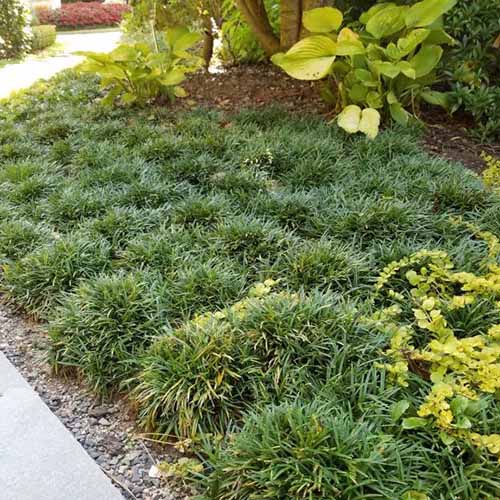
‘Nana’
With a soft, graceful form, dwarf mondo is an outstanding choice for borders, containers, edging, and mass planting. It also makes an easy, non-mowing alternative to turf in low-traffic areas.
Container plants are available at Nature Hills Nursery.
Nigrescens
For a touch of the darkly dramatic, dwarf black mondo grass, O. planiscapus ‘Nigrescens,’ thrills with the deepest shades of aubergine-black and features pretty, white or mauve flowers in summer with pearl-sized, deep purple berries in fall.
The disease-resistant plants grow up to eight inches tall with a 12-inch spread and are hardy in Zones 5 to 10.
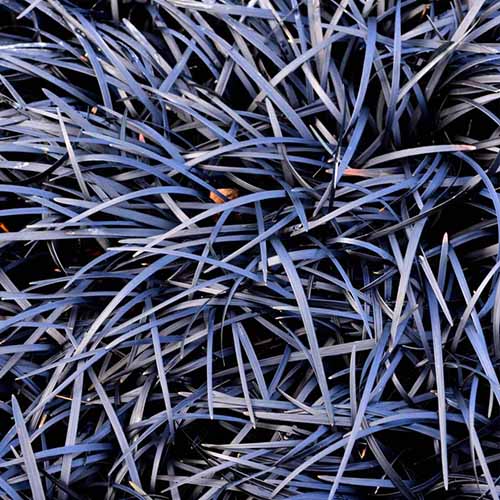
‘Nigrescens’
They make a superb addition in sun-to-shade beds, borders, and containers, and may be grown as a ground cover, or in Asian-style, city, courtyard, and gravel or rock gardens.
This is an outstanding choice for pairing with plants featuring chartreuse or lime-green foliage, like hostas, spirea, and ornamental sweet potato vines.
Container plants are available at Fast Growing Trees.
Mondo Grass
Craving the classic? Featuring an elegant, arching form, standard mondo grass (O. japonica) features strappy, dark green foliage with small racemes of pale blue, mauve, or white summer flowers and pretty, bright blue berries in fall.
Wonderfully low-maintenance and durable, plants grow eight to 12 inches tall and wide and are hardy in Zones 6 to 11.
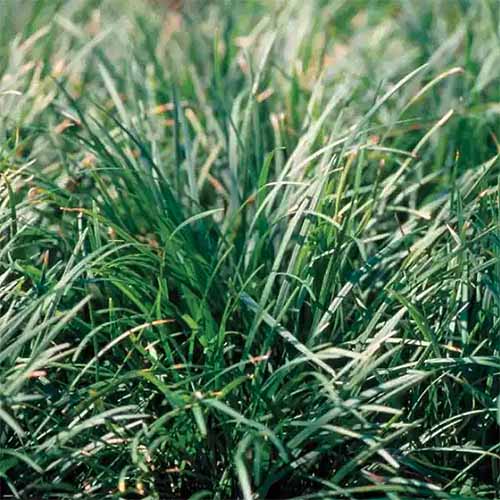
Mondo Grass
A solid performer for beds, borders, containers, edging, ground covers, and underplanting, or in coastal, gravel, and rock gardens.
Container plants can be found at Home Depot.
Managing Pests and Disease
Robust and tough, mondo grass has few problems… but there are a couple of issues to watch for.
Slugs and snails can chew holes in the tender, new foliage of all varieties.
Hand pick and dispose of gastropods in a bucket of soapy water – or use one of the other solutions recommended in our guide on natural methods to protect your garden from slugs and snails.
Overly wet soil can lead to root rot, caused by the water mold Pythium splendens, particularly with dwarf varieties. To prevent root rot, ensure soil is well draining and don’t overwater.
Best Uses
These low-growing, tough evergreens are ideal as a ground cover, a shade-tolerant ornamental for underplanting shrubs and trees, or as a filler between stepping stones.
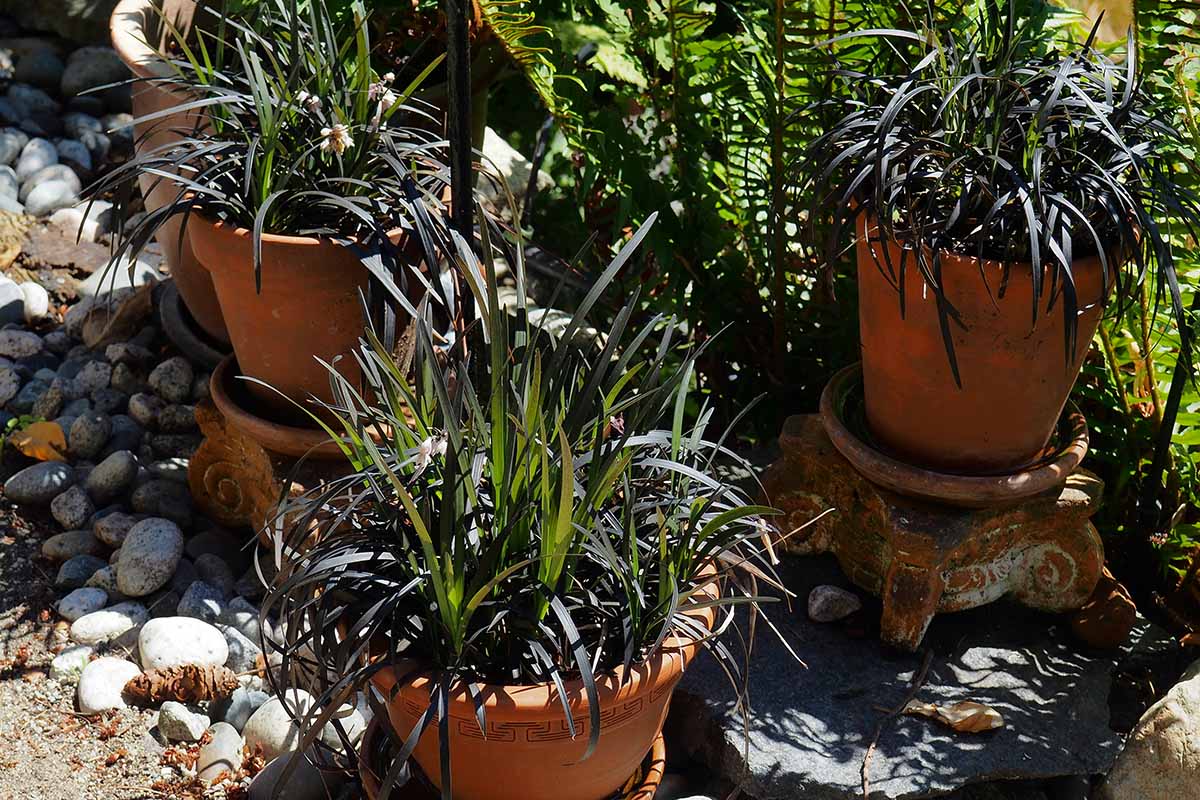
Their tidy growth and uniform mounding add order and structure to borders, containers, and edging, and they’re outstanding in geometric beds and knot gardens.
A natural for flanking streams and ponds, mondo grasses can also be used in a variety of themed settings such as city, courtyard, gravel, meditation, rock, and zen gardens.
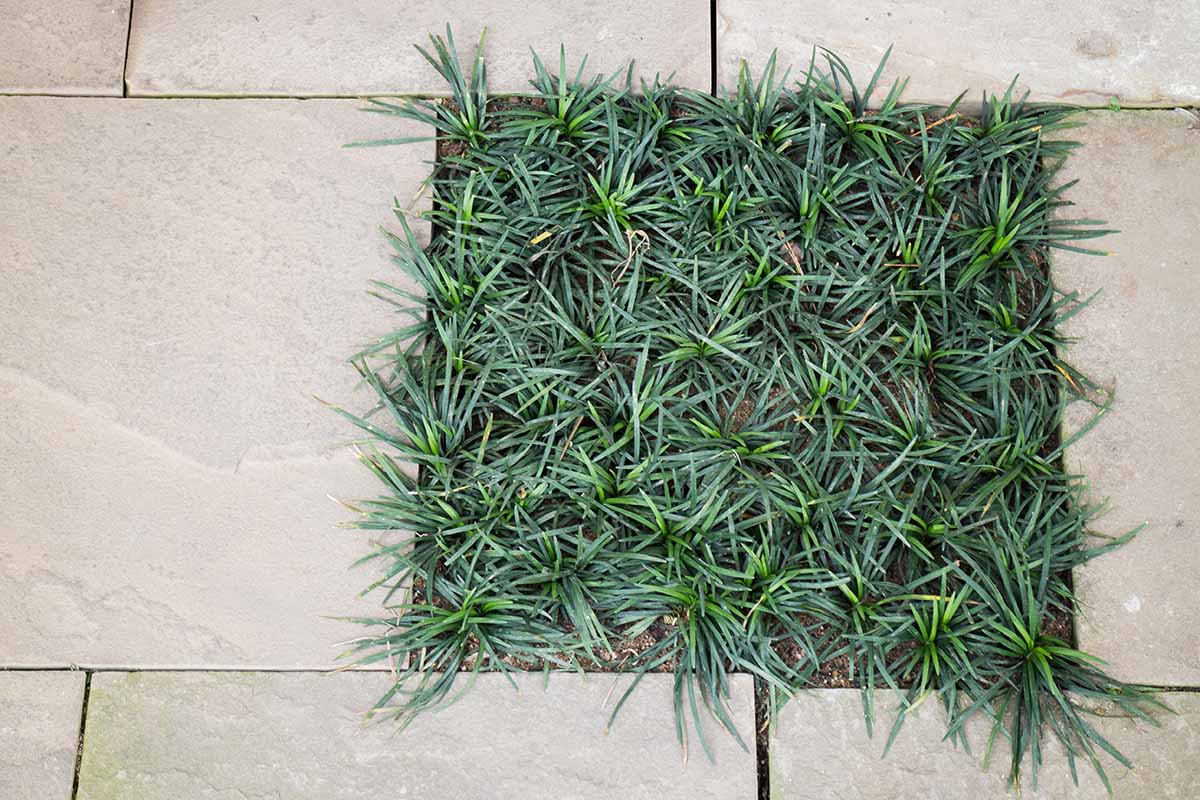
Plus, their salt tolerance makes them a valuable choice for coastal gardens or in beds subjected to salty slush.
Quick Reference Growing Guide
| Plant Type: | Evergreen perennial | Foliage Color: | Pale blue or mauve to white/dark green to black |
| Native to: | Southeast Asia | Tolerance: | Deer, rabbits, salt, shade |
| Hardiness (USDA Zone): | 5-11, depending on variety | Maintenance | Low |
| Bloom Time: | Summer | Soil Type: | Humus-rich |
| Exposure: | Part sun to part shade | Soil pH: | 5.5-6.5 |
| Time to Maturity: | 2-3 years | Soil Drainage: | Well-draining |
| Spacing: | 4-12 inches | Uses: | Beds, borders, containers, edging, ground cover, underplanting; coastal, gravel, rock, and zen gardens |
| Planting Depth: | Crown just below soil level | Order: | Asparagales |
| Height: | 6-15 inches | Family: | Asparagaceae |
| Spread: | 12-18 inches | Genus: | Ophiopogon |
| Water Needs: | Moderate | Species: | Jaburan, japonica, planiscapus |
Short, Dark, and Handsome
For graceful borders, flowing container plants, or a dense, spreading ground cover, low-growing mondo grass makes a short, (mostly) dark, and handsome addition in a variety of settings!
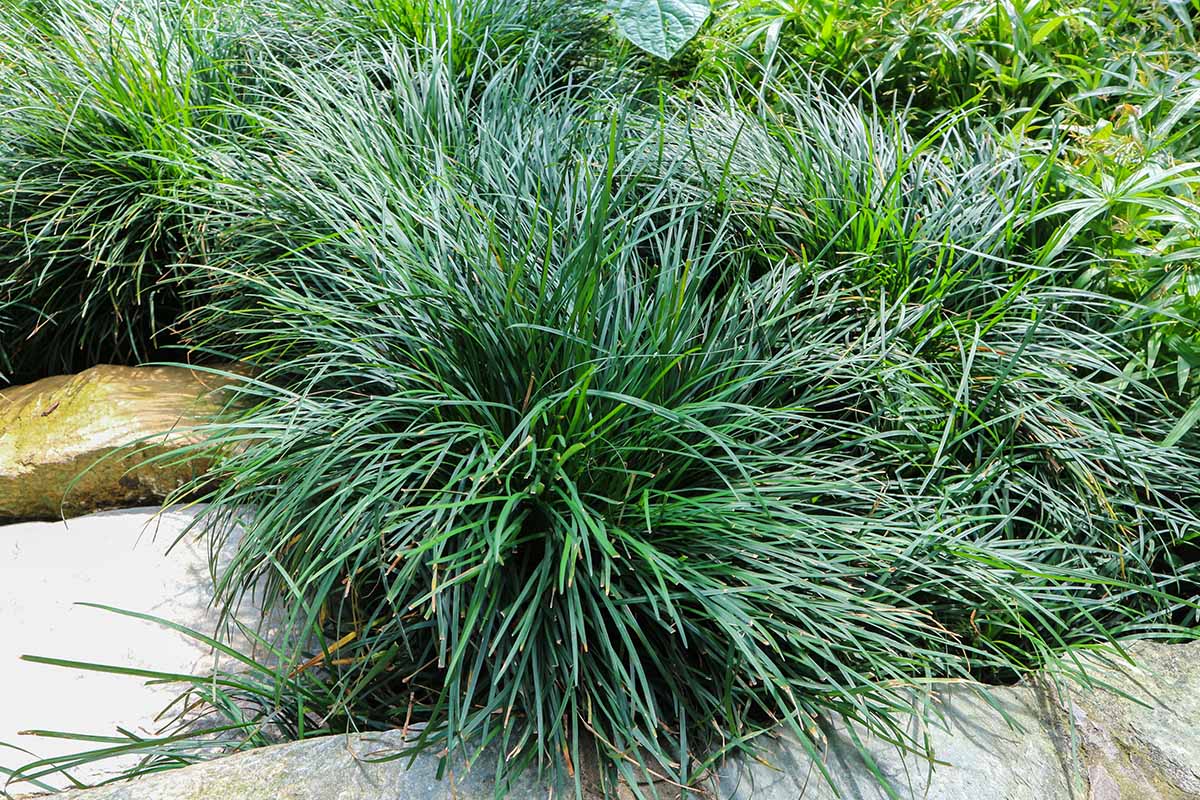
The only must-do requirements for these easy-care, slow-growing plants are to keep the soil lightly moist until they’re established and top-dress with compost in spring. Divide container and specimen plants every few years, and that’s about all they need.
You’ll love the beauty and versatility of these leisurely, low-maintenance plants in both sun and shade gardens.
Do you folks have a favorite cultivar? Let us know in the comments section below.
And for more information about growing ornamental grasses, have a read of these guides next:
[ad_2]
Source link








 + Planting String of Watermelon Succulents
+ Planting String of Watermelon Succulents  with Garden Answer
with Garden Answer


